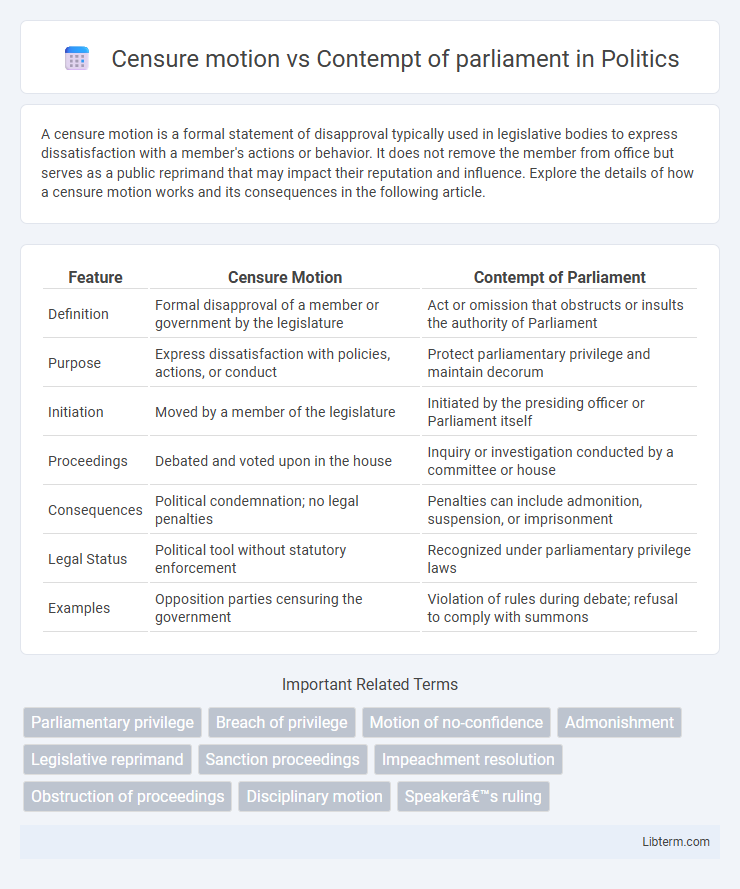A censure motion is a formal statement of disapproval typically used in legislative bodies to express dissatisfaction with a member's actions or behavior. It does not remove the member from office but serves as a public reprimand that may impact their reputation and influence. Explore the details of how a censure motion works and its consequences in the following article.
Table of Comparison
| Feature | Censure Motion | Contempt of Parliament |
|---|---|---|
| Definition | Formal disapproval of a member or government by the legislature | Act or omission that obstructs or insults the authority of Parliament |
| Purpose | Express dissatisfaction with policies, actions, or conduct | Protect parliamentary privilege and maintain decorum |
| Initiation | Moved by a member of the legislature | Initiated by the presiding officer or Parliament itself |
| Proceedings | Debated and voted upon in the house | Inquiry or investigation conducted by a committee or house |
| Consequences | Political condemnation; no legal penalties | Penalties can include admonition, suspension, or imprisonment |
| Legal Status | Political tool without statutory enforcement | Recognized under parliamentary privilege laws |
| Examples | Opposition parties censuring the government | Violation of rules during debate; refusal to comply with summons |
Introduction to Censure Motion and Contempt of Parliament
A censure motion is a formal statement of disapproval against a government official or member within a legislative body, aiming to express dissatisfaction without necessarily leading to removal from office. Contempt of Parliament refers to actions or behaviors that obstruct or disrespect the authority, dignity, or functioning of the parliamentary proceedings, ensuring the institution's integrity is maintained. Both mechanisms serve as tools to uphold accountability and discipline within parliamentary democracies.
Defining Censure Motion: Meaning and Significance
A Censure Motion is a formal expression of disapproval against a government minister or official, highlighting misconduct or failure in duties without resulting in immediate removal from office. It serves as a parliamentary tool to hold members accountable and impact their political credibility by signaling loss of confidence. Unlike Contempt of Parliament, which involves obstruction or disrespect towards the legislative body itself, a Censure Motion specifically addresses individual performance and ethical breaches.
Understanding Contempt of Parliament: An Overview
Contempt of Parliament encompasses acts that obstruct or impede the functioning or dignity of the legislative body, including refusing to comply with summons or providing false evidence. Unlike a censure motion, which serves as a formal expression of disapproval without legal penalties, contempt proceedings can lead to sanctions such as fines, imprisonment, or other disciplinary actions imposed by Parliament. Understanding contempt involves recognizing its role in preserving parliamentary authority and ensuring members and outsiders respect legislative procedures and mandates.
Key Differences between Censure Motion and Contempt of Parliament
A Censure Motion in Parliament is a formal expression of disapproval against a government minister or official, usually triggered by policy failures or misconduct, and requires a majority vote to pass. Contempt of Parliament refers to actions or behaviors that obstruct or disrespect the functioning of Parliament, such as ignoring summons or disrupting proceedings, and is dealt with by parliamentary committees or the Speaker's authority. Key differences lie in their nature: censure targets individuals for misconduct with a political consequence, while contempt addresses breaches of parliamentary privilege affecting institutional integrity.
Objectives and Purposes of Censure Motions
Censure motions serve as formal expressions of disapproval against government officials or policies, aiming to hold members accountable and uphold parliamentary integrity. Their primary objectives include signaling dissatisfaction, prompting policy changes, and reinforcing democratic oversight within legislative frameworks. Unlike contempt of parliament, which addresses breaches obstructing parliamentary functions, censure motions focus on political and ethical accountability.
Situations Leading to Contempt of Parliament
Situations leading to Contempt of Parliament include disobedience to parliamentary orders, obstructing the legislative process, providing false information, or refusing to appear before parliamentary committees. Contempt can also arise from the publication of material that misleads or scandalizes the Parliament or its members. Unlike censure motions that express disapproval of specific actions or policies, contempt addresses direct threats to the authority and functioning of the legislative body.
Procedural Aspects: How Censure Motions are Moved
Censure motions are formally initiated when a member of the parliament submits a notice, typically requiring prior permission and adherence to specific procedural rules such as time allocation and debate limits. The motion is then placed on the agenda by the presiding officer and must be supported by a minimum number of members to be admitted for discussion. Unlike contempt proceedings, which are usually initiated suo moto by the house to address breaches of parliamentary privilege, censure motions specifically target the conduct of ministers or government policies through a structured voting process.
Legal Consequences: Effects of Contempt of Parliament
Contempt of Parliament results in legal consequences such as fines, imprisonment, or exclusion from parliamentary sessions, directly affecting a member's parliamentary privileges and reputation. Unlike a censure motion, which serves as a formal reprimand without legal penalties, contempt charges can lead to enforced disciplinary actions and potential loss of parliamentary rights. Courts may also uphold parliamentary privileges by restricting judicial interference in contempt cases, emphasizing the seriousness of maintaining legislative authority.
Historical Examples: Censure Motions and Contempt Cases
The censure motion against Indian Prime Minister Morarji Desai in 1979 marked a significant historical example, highlighting parliamentary accountability through formal disapproval. The contempt of parliament case involving the Governor of Punjab, S.S. Sidhu in 1984, underscored the legislature's authority to penalize actions obstructing its functions. These landmark instances demonstrate how censure motions and contempt proceedings have functioned as crucial parliamentary tools to uphold discipline and integrity within democratic institutions.
Conclusion: Relevance in Modern Parliamentary Democracy
Censure motions serve as formal expressions of disapproval against government actions, reinforcing accountability in modern parliamentary democracy. Contempt of parliament addresses behaviors that obstruct legislative functions, ensuring the integrity and authority of parliamentary proceedings. Both mechanisms are crucial for maintaining transparency, discipline, and public trust in democratic governance.
Censure motion Infographic

 libterm.com
libterm.com